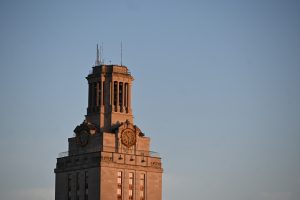UT American Sign Language community bridges deaf and hearing worlds
April 13, 2023
Before becoming an associate professor of American Sign Language in 2007, Deborah White worked with families of deaf infants and was already passionate about teaching.
Now, she teaches students her first language — communicating with visual gestures — through face-to-face interaction and role-playing to immerse them in deaf culture within the classroom.
“I’ve always loved teaching, and I’ve liked to make the class fun and make exciting experiences for my students,” White said. “I don’t like teaching languages (with) the old school method.”
Growing up deaf and attending public school with a small number of deaf students, White said she never hid from the hearing world and gained her passion for deaf education from her mother.
“I want to (create) a bridge between the deaf and hearing worlds,” White said. “Whenever I teach ASL, I can see the students go to clothing stores or coffee shops and meet deaf people, and they’re able to make a connection there. That provides accessibility for deaf people as well.”
UT’s campus stands around three miles from the Texas School for the Deaf. Many deaf-owned businesses occupy the area because of this, White said. She said she believes the University’s proximity gives ASL students opportunities to connect with the deaf community beyond the classroom.
For example, students can volunteer to check tickets for sports events, and White said this provides a way to communicate with and understand different people.
“(With) French and other languages, you’ve got to go all the way overseas to immerse (in the culture),” White said. “What we have right here is right down the block. You don’t have to buy airline tickets.”
Kaylee Loggins, a speech, language and hearing science junior, participates in a student organization called the Deaf Culture Alliance, which creates a safe space for signing and social interaction.
“Sometimes, I don’t feel like I have the words to express what I want to say verbally, and ASL gives me a different way of communicating what I want to say,” Loggins said. “It has changed my entire worldview of how I view people, communication (and) language.”
White said her smaller ASL classes of around 20 students allow students to form a tight-knit community amidst a large sea of people on campus.
“I get to know everyone really well, and we become a family,” White said. “A lot of students will come to my class, and they may feel lost because UT is huge. ASL makes them feel more of a sense of belonging.”
Maya Patel, a speech, language and hearing science senior, acts as a student assistant for ASL classes and said learning the language made a lasting impact on her college experience and career aspirations in audiology.
“It’s such a beautiful language to learn,” Patel said. “Dedicate your time to it. It’s really cool, (and) there’s so much culture (and history) behind it. You can learn a lot from the community and professors here.”
White said although students might not feel comfortable jumping straight into ASL learning, the communal connections and skills they can learn through this language benefits their overall success.
“I want students to appreciate the language, understand the culture and be more culturally sensitive,” White said. “(They can) bring two worlds together and make communication more accessible and more friendly.”












